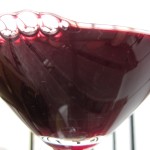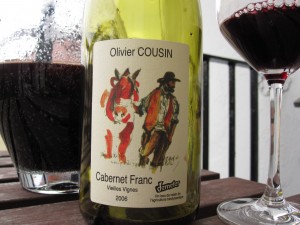
2005 Ghislaine Barthod Bourgogne Rouge (supermodel) VS. 2005 Frank Cornelissen Munjebel Rosso (girl next door)
Many of you are going to think this wasn’t a fair comparison, so I will start this post by addressing that issue.
 Ghislaine Barthod has been among my favorite wine makers in Burgundy for many years. Her Chambolle-Musigny “Les Charmes” can make me dance. I know I am not alone in this opinion. Ghislaine Barthod owns approximately 6.75ha in the Burgundy village of Chambolle-Musigny. Ghislaine took over the wine-making responsibilities from her father Gaston in 1987, and from the 1992 vintage, her name appears on the labels. Ghislaine has since brought down the yields and added a sorting table. There is more temperature control during vinification now, more pigeage (punching down of the cap) and less remontage (pumping over). She now bottles herself rather than contracting out and only fines and filters when absolutely necessary. Her 2005’s are known to be great, even at the Bourgogne Rouge (Village) level. Read the rest of this entry »
Ghislaine Barthod has been among my favorite wine makers in Burgundy for many years. Her Chambolle-Musigny “Les Charmes” can make me dance. I know I am not alone in this opinion. Ghislaine Barthod owns approximately 6.75ha in the Burgundy village of Chambolle-Musigny. Ghislaine took over the wine-making responsibilities from her father Gaston in 1987, and from the 1992 vintage, her name appears on the labels. Ghislaine has since brought down the yields and added a sorting table. There is more temperature control during vinification now, more pigeage (punching down of the cap) and less remontage (pumping over). She now bottles herself rather than contracting out and only fines and filters when absolutely necessary. Her 2005’s are known to be great, even at the Bourgogne Rouge (Village) level. Read the rest of this entry »
 Domaine Cousin-Leduc
Domaine Cousin-Leduc
7 Rue du Colonel Panaget
49540 Martigné-Briand
France
 By now, you know the story. Biodynamic, plowing with horses, hand harvesting, spontaneous fermentation, long maceration and no SO2. A good friend of Patrick Desplats & Sébastien Dervieux at Domaine Griottes, Olivier follows basically the same methods (or lack of). Domaine Cousin-Leduc is in Martigné-Briand which lies in the Anjou appellation of The Loire Valley (see map). Although The Loire Valley’s white wines reach a broader audience (think Sancerre), the reds are my favorite.
By now, you know the story. Biodynamic, plowing with horses, hand harvesting, spontaneous fermentation, long maceration and no SO2. A good friend of Patrick Desplats & Sébastien Dervieux at Domaine Griottes, Olivier follows basically the same methods (or lack of). Domaine Cousin-Leduc is in Martigné-Briand which lies in the Anjou appellation of The Loire Valley (see map). Although The Loire Valley’s white wines reach a broader audience (think Sancerre), the reds are my favorite.


Date tasted: May 23, 2010 decanted at 1800 (I chose to decant this wine because the last time I tasted it about 6 months ago, initial aromas were dominated by oak and they took a few hours to burn off)
 Appearance: Dark cherry red. Not much development showing if any at all. Clear
Appearance: Dark cherry red. Not much development showing if any at all. Clear
Nose: Sponty, floral (light rose pedals), dark plums, blueberry juice with hint of raspberry and other red fruits. Not much development (I have not tasted a younger version of this wine, so there may be some development from that point of view)
Palate: Quite salty (& mineral) on the initial impression followed by under ripe cherries. Very structured wine withdark fruit and hints of red fruit. Very light and fresh. Hints of leather and oak (just hints) and a slight bitterness on the finish. Slight green notes (but not under ripe). Medium, ripe and juicy acidity and medium tannins. Not much development on the palate either.

As we consumed the bottle, the salty, mineral notes stayed with the wine which I considered a positive characteristic of the wine and enjoyed it very much.
I last tasted this wine in November of 2009 and remembered the oak being a bit more dominant (although judicial by most standards). Today I found the oak to be quite well integrated and overall I found the wine to be very refreshing and drinkable.
 Champagne Fleury S.A.
43 Grande Rue
10250 Courteron – France
tel: (+33) 03.25.38.20.28
Champagne Fleury S.A.
43 Grande Rue
10250 Courteron – France
tel: (+33) 03.25.38.20.28
The Fleury family used to grow grapes to sell to other Champagne houses. They stopped doing this in 1929 due to the financial crisis and produced their first vintage that year. In 1989 they converted to Biodynamic viticulture – the first house in Champagne to do so – the first plot to convert being a small 3ha plot. They were officially certified in 1992 and they had their first certified biodynamic vintage in 1995. Today, they own about 15ha and purchase another 12ha of biodynamically farmed grapes. They have an annual production of approx 200,000 bottles. Read the rest of this entry »

This project of mine started when I ordered a case of Frank Cornelissen Munjebel Bianco 5 and was lucky enough (rather unlucky) to receive a case with an open bottle. This was the infamous bottle I had heard about a few months back. I was speaking to importers of this wine and they mentioned they had a customer of the Vinmonopolet (Wine Monopoly) return a case of the wine because they thought there was something wrong with it (we won’t get into this here, you know it’s my favorite wine…). When I discovered this open bottle in the case, I thought “what the hell?! Why would they send this to me without opening the case and checking?!”
Well, you know the old saying. Nature gives you lemons, you make lemonade. In this case nature gave me an almost completely full bottle of Munjebel Bianco, so I thought “why not make un-sulfured vinegar?”. So here it is, about 6 months after I started this project.
I apologize in advance to the wine makers for converting their lovely wines into a lovely vinegar. I am storing the vinegar in a magnum bottle. Only unsulfured wines will be added as needed).
 Color: Orange, copper.. Well you see in the picture!
Color: Orange, copper.. Well you see in the picture!
Aromas: Acidic, vinegary with hints of orange citrus and toasted hazel nuts
Taste: First attack is orange peel with hints of fresh fruit which is immediately followed by a grapefruit and vinegar taste. Medium acid with a slightly nutty finish. Very fresh and persistent finish which lingers without too much burning at the back of the throat.
, vinegar with hints of orange citrus and toasted hazel nuts

 Ghislaine Barthod has been among my favorite wine makers in Burgundy for many years. Her Chambolle-Musigny “Les Charmes” can make me dance. I know I am not alone in this opinion. Ghislaine Barthod owns approximately 6.75ha in the Burgundy village of Chambolle-Musigny. Ghislaine took over the wine-making responsibilities from her father Gaston in 1987, and from the 1992 vintage, her name appears on the labels. Ghislaine has since brought down the yields and added a sorting table. There is more temperature control during vinification now, more pigeage (punching down of the cap) and less remontage (pumping over). She now bottles herself rather than contracting out and only fines and filters when absolutely necessary. Her 2005’s are known to be great, even at the Bourgogne Rouge (Village) level. Read the rest of this entry »
Ghislaine Barthod has been among my favorite wine makers in Burgundy for many years. Her Chambolle-Musigny “Les Charmes” can make me dance. I know I am not alone in this opinion. Ghislaine Barthod owns approximately 6.75ha in the Burgundy village of Chambolle-Musigny. Ghislaine took over the wine-making responsibilities from her father Gaston in 1987, and from the 1992 vintage, her name appears on the labels. Ghislaine has since brought down the yields and added a sorting table. There is more temperature control during vinification now, more pigeage (punching down of the cap) and less remontage (pumping over). She now bottles herself rather than contracting out and only fines and filters when absolutely necessary. Her 2005’s are known to be great, even at the Bourgogne Rouge (Village) level. Read the rest of this entry »







